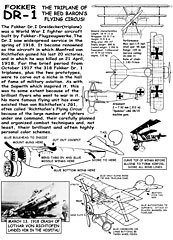


Fokker Dr1 - $$5.50
This Dr-1 is just one model as opposed to the entire collection of 18. Chosen for this special model is the Red Baron's 425/17 all red Dr-1. THIS is the plane in which he died on that fateful April 29, 1918. The Red Baron flew many types of WWI Scouts. Fiddlersgreen offers models of MOST.
Fokker Dr-1 Triplane
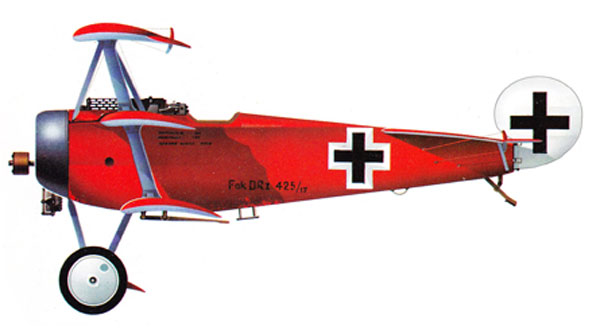
The Fokker Dr-1 Triplane:
Perhaps the most famous fighter of all time. The triplane number 425/17 was the last mount of the 'Red Baron', Rittmeister Manfred Freiherr von Richthofen, the top-scoring ace of World War 1 with 80 confirmed kills. He was shot down on April 21,+ 1918 and the controversy continues to this day as to WHO actually did it.
This webpage is for the single Fokker Dr-1, the Fokker Dr-1 Collection which has 18 different versions.
Click HERE to get to the Fokker Dr-1 Collection model offer.
Fokker Dr 1 Triplane
the Dr. l was a Rip-Off of the Sopwith Triplane
Flown by such men as Manfred von Richthofen, the small number built shot down many times their own number of Allied Scouts on the Western Front. It was in one of these aircraft that von Richthofen, the legendary Red Baron, met his death. Manfred von Richthofen and his scarlet Fokker Dr. l triplane have become a legend in their own right. This is despite the fact that Lieutenant Werner Voss shot down many more aircraft from his Fokker triplane, and von Richthofen's kills were mostly achieved with other aircraft. What is more, the number of these aircraft flying in World War 1 was comparatively small, and it was only designed as an answer to.. and built along the same lines as, the British Sopwith Triplane.
But the renown of the Fokker Dr. 1 still eclipses that of any other aircraft which flew in the Great War- The War to End all Wars.
Released by the Sopwith Experimental Department in May 1916, the first Triplane was a very slick fighting scout with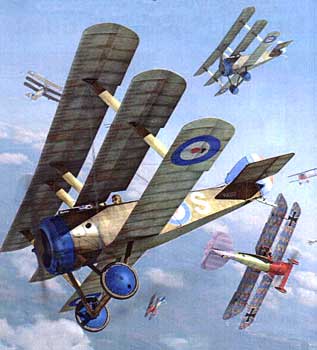 a fuselage and tail almost identical to those of the Sopwith Pup, perhaps the most agile and well loved aircraft of its day. Sopwith designed the Triplane for several reasons..Its' three wings were much narrower (smaller chord than the biplane wings of the Pup, although the span remained unchanged the wing area actually was reduced. The more powerful 130-hp instead of the 100-hp engine made the Triplane significantly faster. The narrower wings gave the pilot a better view especially as the middle wing was on the same level as his eyes.
a fuselage and tail almost identical to those of the Sopwith Pup, perhaps the most agile and well loved aircraft of its day. Sopwith designed the Triplane for several reasons..Its' three wings were much narrower (smaller chord than the biplane wings of the Pup, although the span remained unchanged the wing area actually was reduced. The more powerful 130-hp instead of the 100-hp engine made the Triplane significantly faster. The narrower wings gave the pilot a better view especially as the middle wing was on the same level as his eyes.
The narrow chord also meant that the center of pressure (the point through which the resultant lift force acts) did not move so far from the front to rear, or vice versa, as in a normal broad-winged machine during violent maneuvers. This also meant the fuselage AND the wing span could be short enhancing maneuverability.
All the airplanes went to the Royal Naval Air Service and, because of the tremendous aggressiveness and skill of the pilots, soon struck a chill into the hearts of German fliers. The triplanes really got into action during the Battle Sol Arras in April 1917. So great was their success that an official historian wrote: 'The sight of a Triplane formation induced the enemy pilots to dive out of range'.
The moment the first Sopwith Triplane crashed behind the German lines the wreckage was studied in the finest detail. Even the commander of the Imperial German Air Service, General von Hoppner, publicly eulogized the British fighter. By the spring of 1917 almost every important aircraft company in the Central Powers - at least 14 - had a design team furiously trying to produce a triplane fighter. But it was the wily Dutchman, Anthony Fokker, who achieved success. So eager was he to beat his rivals that, as well as studying the Sopwith Triplanes at first hand, flying at the front, he completely illegally had the wreckage from the first crashed Triplane sent to his own factory at Schwerin! 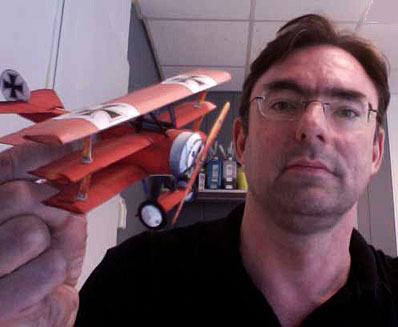
The latest fighter prototype at the Schwerin works at that time was the D.VI (a company designation unrelated to the later production D.VI), intended for the Luftfahrttruppe (air force) of Austro-Hungary. In June 1917, chief designer Reinold Platz quickly re-drew the drawings and the D.VI emerged around 1 July 1977 as the first triplane to fly in Germany. It was immediately tested by Lt Werner Voss, who was already a famed ace.
Platz had already designed extremely advanced biplane fighters with completely cantilever wings,and he made the D-VI the same way, unbraced wings being easier on a short-span triplane. The two lower wings were attached to the top and bottom of the fuselage, and the only struts were long steel-tube inverted-Vee cabane struts carrying the top wing high above the fuselage. This wing was the only one with ailerons, whereas the Sopwith Triplane had had ailerons on all three wings, linked by light rods-. Powered by a 110-hp Oberurlel Ur.II rotary-engine, the D.VI flew excellently, though before being sent to Hungary in August the upper wing, with its ailerons, was increased in span. To eliminate slight wing vibration, light wooden streamline I-type struts were added linking the wings near their tips. Armament was two synchronized 7.29-mm LMG 08/15 guns.
Action at the Front
Lt Voss spent over 20 hours testing the two V 4 prototype triplanes in August 1917, and by the end of that month had them to his satisfaction. Both had by that time seen action at the front, and Fokker himself had also done a lot of active flying in them (previously he had had to don the uniform of a German officer and fly on active operational missions to test his synchronizing gear, despite the fact he was a Dutch civilian!).
Voss made the first operational flight in Fok.103/17 on 30 August 30 1917. He claimed a victory on this mission. Two days later, on September 1, von Richthofen flew the original V 4 (7021 17) and scored his 60th victory. Voss monopolized the second Dr. 1 (103/17) scoring a remarkable 20 confirmed victories in it in 24 days before being killed in a classic fight on 23 September with no fewer than six S.E.5a fighters.-
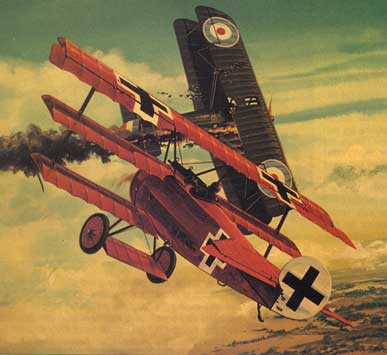 Structurally it was typical Fokker and Platz, with very strong mixed construction. The wings were almost wholly wood, with steel at the main joints and the attachments of bracing wires. Each wing had a single built-up box spar with main longerons of spindled (machined away for lightness on a router) hardwood, carrying built-up plywood ribs. Trailing edges were wire, resulting in the characteristic scalloped appearance when the fabric covering was doped and tightened.
Structurally it was typical Fokker and Platz, with very strong mixed construction. The wings were almost wholly wood, with steel at the main joints and the attachments of bracing wires. Each wing had a single built-up box spar with main longerons of spindled (machined away for lightness on a router) hardwood, carrying built-up plywood ribs. Trailing edges were wire, resulting in the characteristic scalloped appearance when the fabric covering was doped and tightened.
The small fuselage and tail were accurately welded in jigs from pre-shaped steel tubes, the fuselage then having light wooden fairings added prior to being covered in fabric. The traditional rubber-sprung main landing gears had an axlefaired by a small wing, a feature of many Fokker fighters.
Again a common feature of the day was the absence of a fin, the only vertical tail surface being the simple rounded rudder pivoted to the fuselage sternpost. The small riveted fuel tank was immediately behind the spinning engine, and beneath the guns; the usual armament, seldom altered in practice, comprised two LMG 08/15 (commonly called 'spandau') machine-guns with belt magazines inside the fuselage behind the tank and the breeches immediately in front of the pilot inside the cockpit.
It added up to a simple, relatively cheap and fairly agile fighter, which with the standard 110-hp engine could climb faster than many more powerful aircraft and also turn inside them, a factor which in a dogfight was vital.But the speed was unimpressive by late 1917 standards and the range and endurance were exceptionally poor - only a skilled pilot could keep a Dr. 1 airborne longer than 80 minutes where as 2 (if not 3) hours was easily within the grasp of all Allied fighter pilots.
Richthofen's Flying Circus
But for the brief period from October 1917 the 318 Fokker Dr. 1 triplanes, plus the two prototypes, were to carve 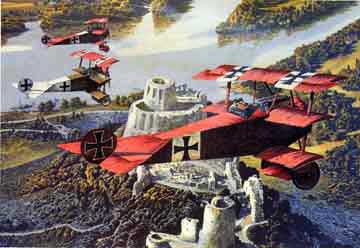 out a niche in the hall of fame of military aviation. As with the Sopwith which inspired it, this was to some extent because of the brilliant flyers who went to war in it. No more famous flying unit has ever existed than von Richthofen's JG1, often called 'Richthofen's Flying Circus' because of the large number of fighters under one command, their carefully planned and organized combat techniques and, not least, their brilliant and often highly personal color schemes.
out a niche in the hall of fame of military aviation. As with the Sopwith which inspired it, this was to some extent because of the brilliant flyers who went to war in it. No more famous flying unit has ever existed than von Richthofen's JG1, often called 'Richthofen's Flying Circus' because of the large number of fighters under one command, their carefully planned and organized combat techniques and, not least, their brilliant and often highly personal color schemes.
The successful service career of the Dr. 1 was briefly marred by a spate of crashes in the first two weeks of combat duty by production aircraft. The cause was eventually traced to shockingly bad workmanship at the Schwerin factory, and all Dr.Is were at once grounded until their wings had been stripped of fabric and inspected. In many cases properly made wing spars had to be produced, and the factory spent almost the whole of November 1917 urgently repairing or rebuilding the wings of Dr. 1s. Thus it was not really until late November that the Dr. 1 became effective in numbers on the Western Front, and it is remarkable that such a relatively small number of a basically outdated design should have acquired so great a reputation.
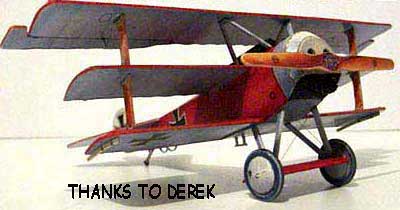 This reputation is, of course, inextricably interwoven with the great Red Baron himself, Rittmeister Manfred, Freiherrvon Richthofen, a German aristocrat who was the top-scoring ace of World War 1. and perhaps the most famous fighter pilot of all time. Though most of his victories had been gained on other types, such as the Albatros D.III, he favored the Dr. 1 over faster biplanes and continued to fly one almost exclusively on combat missions in 1918. It was in one of two Dr.Is regularly flown by him that he met his death on April 21, 1918 - probably at the hands of Roy Brown, a Canadian captain with No. 209 Squadron, RAF (the RAF was then just 20 days old). The Freiherr (not actually a baron) died from a single bullet that went diagonally through his body, penetrating the heart.
This reputation is, of course, inextricably interwoven with the great Red Baron himself, Rittmeister Manfred, Freiherrvon Richthofen, a German aristocrat who was the top-scoring ace of World War 1. and perhaps the most famous fighter pilot of all time. Though most of his victories had been gained on other types, such as the Albatros D.III, he favored the Dr. 1 over faster biplanes and continued to fly one almost exclusively on combat missions in 1918. It was in one of two Dr.Is regularly flown by him that he met his death on April 21, 1918 - probably at the hands of Roy Brown, a Canadian captain with No. 209 Squadron, RAF (the RAF was then just 20 days old). The Freiherr (not actually a baron) died from a single bullet that went diagonally through his body, penetrating the heart.
The last Dr. 1 was delivered in May 1918, at a time when this type was rapidly being taken out of service in favor of the considerably superior Fokker D.VII. At no time were there more than 171 Dr. 1s in active service - the maximum was reached in May 1918 - and by the middle of june this had fallen to 125. During the summer, most of them had been transferred back to Germany to defend their home territory.
Other famous Dr. 1 pilots apart from Richthofen were Kurt Wolff, with 33 aircraft shot down, Voss with 48, Erich Lowenhardt with 53, and Ernst Udet with 62. Richthofen himself had 80 kills to his credit.
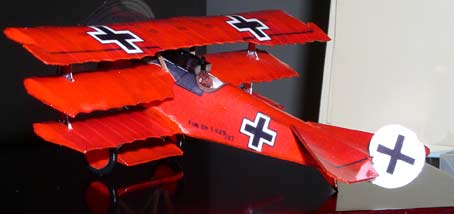 |
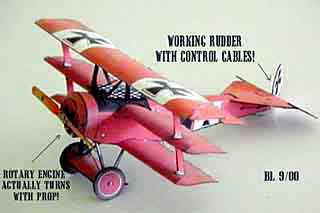 |
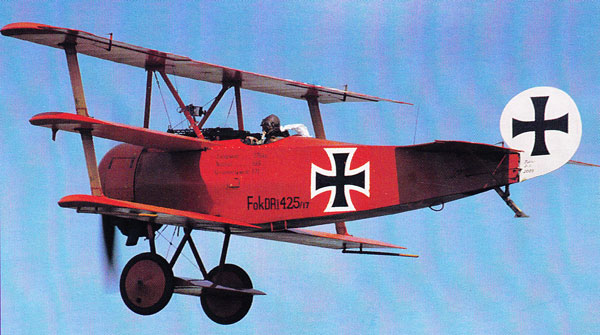
Specifications for the Fokker DR.1 Triplane
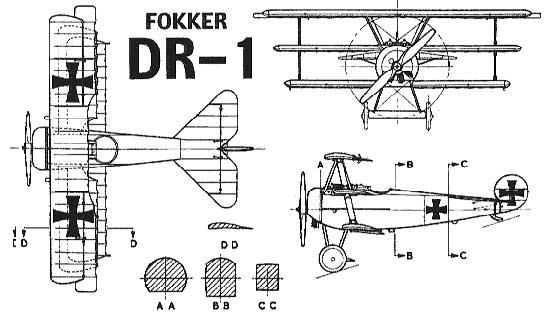 |
Length: 18 ft 11 in Wingspan: 23 ft 7 in Height: 9 ft 8 in Wing area: 201 ft² Empty weight: 895 lb Loaded weight: 1,292 lb Powerplant: 1× Oberursel Ur.II 9-cylinder rotary engine, 110 hp Zero-lift drag coefficient: 0.0323 Drag area: 6.69 ft² Aspect ratio: 4.04 Performance Maximum speed: 115 mph Stall speed: 45 mph Range: 185 mi Service ceiling: 20,000 ft Rate of climb: 1,130 ft/min Lift-to-drag ratio: 8.0 Armament 2 × 7.92 mm (.312 in) "Spandau" LMG 08/15 machine guns. |
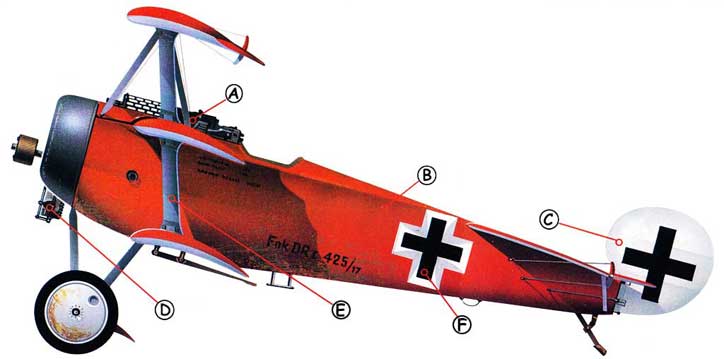 |
||
| A: Two fixed Spandau machine guns were synchronized to fire through the propeller arc. They could be fired independently. | B: Richthofen flew four triplanes in total, one of which (152/17) was displayed after the war in a Berlin museum. It was destroyed by Allied bombs in 1944. | C: Contrary to many reports, this aircraft was far from being all-red. It featured a blue underside, metal cowling and white wheels and vertical tail. |
| D: The Fokker Dr. 1 (or F.I as it was originally known), was powered by either an Oberursel UR II or Thulin-built Le Rhone nine-cylinder rotary engine rated at 110 hp. and driving a two- blade, 8-ft. 6-in. wooden propeller. | E: During late 1917 a number of pilots were killed after the main wing structure failed, causing the Dr. 1 to be temporarily grounded. | F: On this aircraft the straight-sided national marking, known as the 'Balkenkreuz', had been recently applied, with traces of the original 'Iron Cross' still visible. |
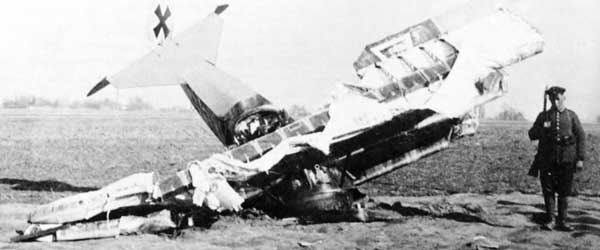 |
| The crash of Lothar Von Richthofen' Dr-1 that landed him in the hospital. Misssing pieces of fabric thanks to souvenior hunters. Remaining pieces, thanks to the guard standing by. |
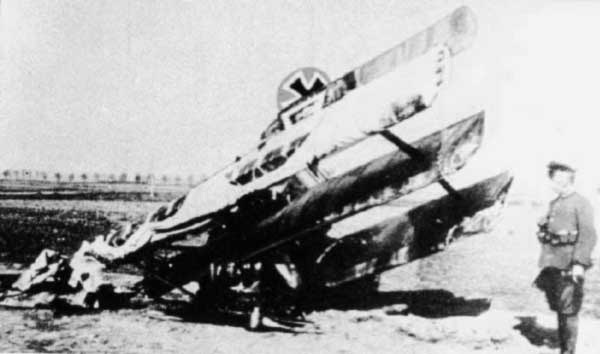 Another view of the crashed Fokker Dr-1 triplane (and guard :) |
Summary
Fokker Dr-1 Triplane
The Fokker Dr.I Triplane, designed by Reinhold Platz and inspired by the Sopwith Triplane, was a German World War I fighter renowned for its maneuverability despite modest speed, first flying in July 1917 and entering service in October that year. Powered by an 110-hp Oberursel Ur.II rotary engine, it featured a wingspan of 7.19 meters, length of 5.77 meters, height of 2.95 meters, empty weight of 405 kg, and maximum speed of 185 km/h, with a range of 300 km and ceiling of 6,100 meters; armed with two 7.92mm LMG 08/15 machine guns. Famous for Manfred von Richthofen's "Red Baron" exploits, achieving 19 victories in it before his death on April 21, 1918, the Dr.I excelled in climbing and turning but suffered early wing failures due to poor construction, leading to groundings and fixes. Only 320 were built, peaking at 171 in service by April 1918, before being replaced by the D.VII; no originals survive, but replicas preserve its legacy as a dogfighting icon.
Fokker Dr-1 YouTube video
The Red Baron's Jasta 11 Fokker Dr.1 triplanes from WW1 (runtime of 10 minutes)


